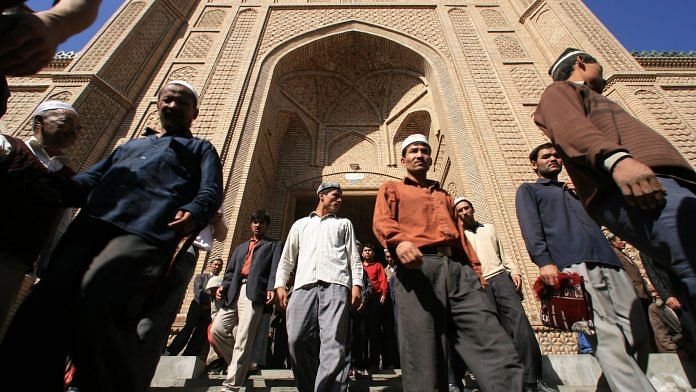When the Beijing Winter Olympics open on February 4, diplomats from a number of countries, including the US, UK, Canada and Australia, will not be there to watch. Their diplomatic boycott hinges on concerns about human rights abuses in China’s Xinjiang Uyghur Autonomous Region. In this episode of The Conversation Weekly, we talk to three experts about China’s long-term vision for Xinjiang, and what its strategy there means for the region’s persecuted Uyghurs.
We also look at the toxic heavy metals are lingering in people’s homes. A researcher, who receives vacuum cleaner dust in the mail from around the world and tests it, reveals what she found.
International pressure is mounting on the Chinese government over the situation in Xinjiang. In December, soon after news of the diplomatic Olympic boycott emerged, the unofficial, London-based Uyghur Tribunal found that the People’s Republic of China had committed genocide, crimes against humanity and torture against Uyghurs, Kazakhs and other minority groups in the Xinjiang region. The tribunal is independent and its verdict has no force under international law. China dismissed its verdict and said allegations of forced labour and genocide were “vicious rumours”. However, in the aftermath, the office of the UN High Commissioner for Human Rights said it would soon publish an assessment of the situation in the Xinjiang region.
It’s difficult for researchers to get a full picture of what’s happening today in the region. Darren Byler, a senior lecturer in politics and international relations at Simon Fraser University in Canada, who has lived in Xinjiang and last visited in 2018, says he gets his information from news passed to members of the Uyghur diaspora by family and friends. Byler says it appears fewer Uyghurs are now being detained by the authorities in internment camps than they were a few years go. However, he says there’s widespread family separation and “hundreds of thousands of people are still missing”. Those outside the camps live under a repressive surveillance system in “sort of an open air prison”, he says.
Several camps have been closed or abandoned, others turned into pre-trial detention centres, while others have been turned into factories. “It does appear as though the state was maybe acting more re-actively to international pressure and wanting to close them more quickly than they were at least intending at the outset,” says Byler.
David Tobin, a lecturer in east Asian studies at the University of Sheffield in the UK, explains the longer history of China’s relationship with Xinjiang and the Uyghurs. “The underlying problem in how Xinjiang is is governed in China is the notion that Uyghurs were barbarians and became human by becoming Chinese in 1949,” says Tobin. “And then when they start to be seen as human it’s only because they have to be integrated into China.” While this history is vital to understand what’s happening in Xinjiang today, he says the repression against Uyghurs wasn’t inevitable. “We could have had a different turn of events, different leaders with some different ideas,” he says.
Xinjiang’s position in north-west China gives the region added economic importance in the country’s plans to boost trade with its neighbours. “Xinjiang sits in a strategic and pivotal location for the Belt and Road Initiative,” says Anna Hayes, a senior lecturer in politics and international relations at James Cook University in Australia. It’s China’s gateway to the Middle East, central Asia and Europe, she says. “There’s a real hope that Xinjiang will be massively transformed into a hub of manufacturing and natural resource extraction,” Hayes explains, with the southern city of Kashgar as the region’s economic centre of gravity. But underlying this strategy, she warns, is a settler-colonial mindset that sees the indigenous Uyghur population as the “grunt labour force” in this economic transformation.
In our second story in this episode, we talk to Cynthia Isley, postdoctoral research fellow in environmental science at Macquarie University in Australia about her recent study of house dust from around the world. Isley and her colleagues sifted through more than 3,000 samples from 35 countries to understand what toxic trace metals lurk inside our homes – and how to make your home safer. (Listen from 35m40s)
And finally, Matt Williams, breaking news editor at The Conversation based in New York, recommends his picks of recent analysis on the buildup of Russian troops on the Ukrainian border. (From 46m15s)
This episode of The Conversation Weekly was produced by Mend Mariwany and Gemma Ware, with sound design by Eloise Stevens. Our theme music is by Neeta Sarl. You can find us on Twitter @TC_Audio, on Instagram at theconversationdotcom or via email. You can also sign up to The Conversation’s free daily email here. A transcript of this episode is available here.
Newsclips in this episode are from Sky News, WION, BBC News, 7News Australia, ITV News and CNA.
You can listen to The Conversation Weekly via any of the apps listed above, download it directly via our RSS feed, or find out how else to listen here.![]()
Gemma Ware, Editor and Co-Host, The Conversation Weekly Podcast, The Conversation and Daniel Merino, Assistant Science Editor & Co-Host of The Conversation Weekly Podcast, The Conversation
This article is republished from The Conversation under a Creative Commons license. Read the original article.
Also read: What happens after Xi Jinping’s plans for ‘lifelong position’ as President? China has no idea
![]()






